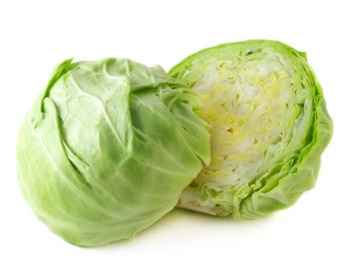Cabbage
From Wikiwel
See also :
Special Precautions of Cabbage
- Anti-Thyroid or Goitrogenic : All members of the cabbage family -- broccoli, Brussels sprouts, cabbage, Chinese cabbage, kale, mustard, turnip, black red radish -- can cause goiter because they all contain glucosinolates. Glucosinolates are modified amino acids. Goiter is the enlargement of the thyroid gland due to iodine deficiency. When radish is chopped or chewed, glucosinolates break down into isothiocyanate, oxazalidine-2-thione, nitrite and thiocyanate ion. Isothiocyanates, oxazalidine-2-thione and isothiocyanate ion can cause goiter, by interfering with the production and secretion of essential thyroid hormones. Without these hormones, the body's ability to burn and use energy is jeopardized.
- Cruciferous Vegetables are excellent accumulators of heavy metals, including thallium. Cruciferous vegetables include: kale, broccoli, cauliflower, cabbage, brussels sprouts, collard and mustard greens. While considering kale’s explosion in popularity, Hrecent reports made the link between cruciferous vegetables and possible thallium toxicity.
The benefits of Cabbage are
- Cabbage is a powerhouse source of vitamins K and C. Just one cup supplies 91 percent of the recommended daily amount for vitamin K, 50 percent of vitamin C, good amounts of fiber, and decent scores of manganese, vitamin B6, folate, and more and it’ll only cost you about 33 calories. Calorie for calorie, cabbage offers 11 percent more vitamin C than oranges.
- Prevents Cancer : Cabbage contains high levels of antioxidant sulforaphanes that not only fight free radicals before they damage DNA but also stimulate enzymes that detoxify carcinogens in the body. Researchers believe this one-two approach may contribute to the apparent ability of cruciferous vegetables to reduce the risk of cancer more effectively than any other plant food group. Numerous studies point to a strong association between diets high in cruciferous vegetables and a low incidence of lung, colon, breast, ovarian, and bladder cancers. Thanks to sinigrin that is found in the vegetable. Sinigrin is a glucosinolate that can be converted into allyl-isothiocyanate, a compound that can prevent the development of cancer cells. How much: The more cabbage you can include in your diet, the better. A study of Polish women found that those who ate at least four servings of cabbage per week as adolescents were 72 percent less likely to develop breast cancer later in life than their peers who consumed only one weekly serving or less.
- Cabbage builds strong bones, dampens allergic reactions, reduces inflammation, and promotes gastrointestinal health. Cabbage is routinely juiced as a natural remedy for healing peptic ulcers due to its high glutamine content. It also provides significant cardiovascular benefit by preventing plaque formation in the blood vessels. In Chinese medicine, cabbage is used to treat constipation, the common cold, whooping cough, depression and irritability, and stomach ulcers. When eaten and used as a poultice, as a dual treatment, cabbage is helpful for healing bedsores, varicose veins, and arthritis.
- Cabbage is very effective in reducing cholesterol in the body. The way it works is that it gets together with the bile acids in the digestive system and lets them out of the body and reduces the levels of cholesterol in the body.
- anti-microbial properties which can kill all kinds of diseases naturally. The antibiotic properties of cabbage are increased once it has been fermented as well. So eat your sauerkraut, or better yet, make your own.
